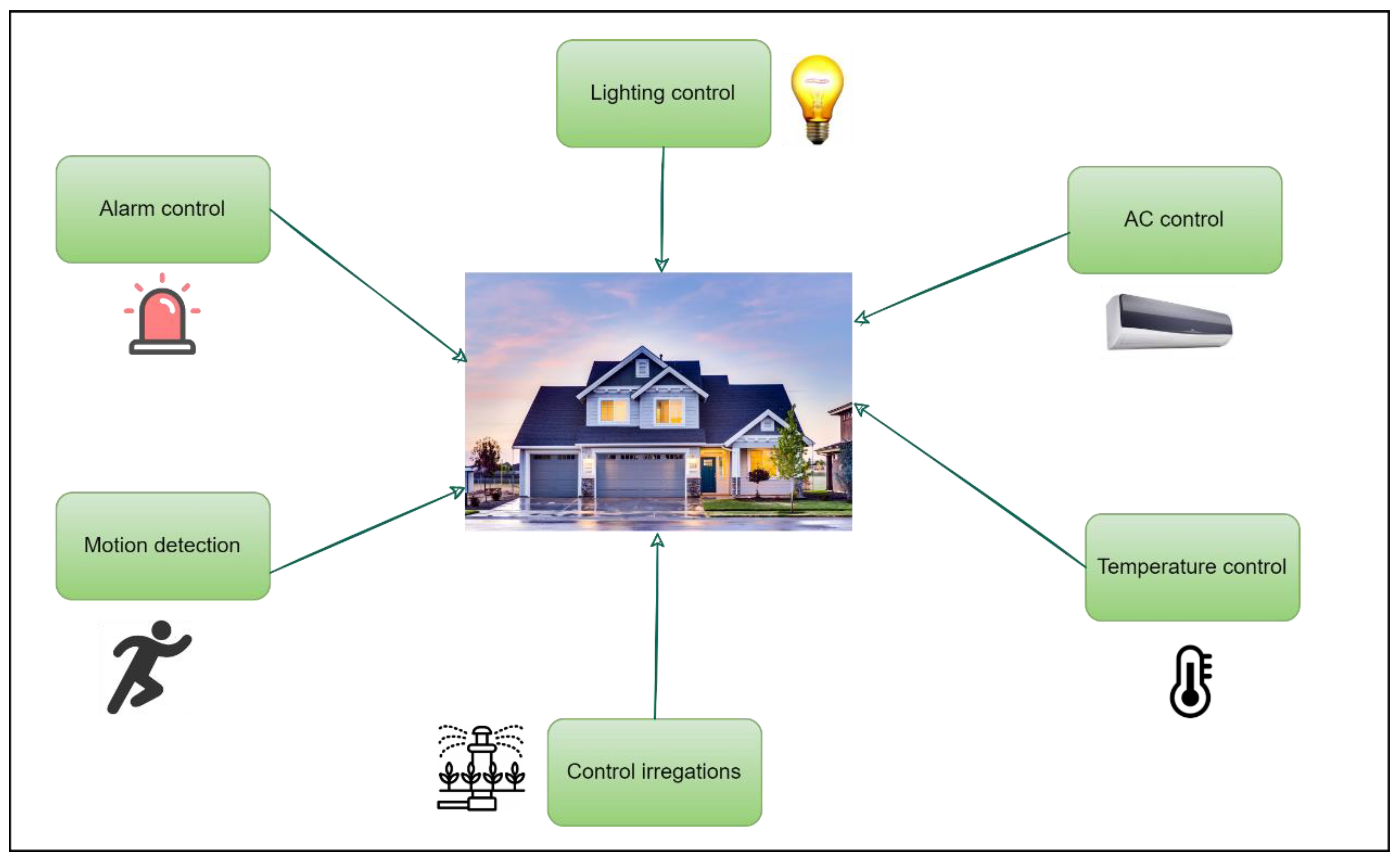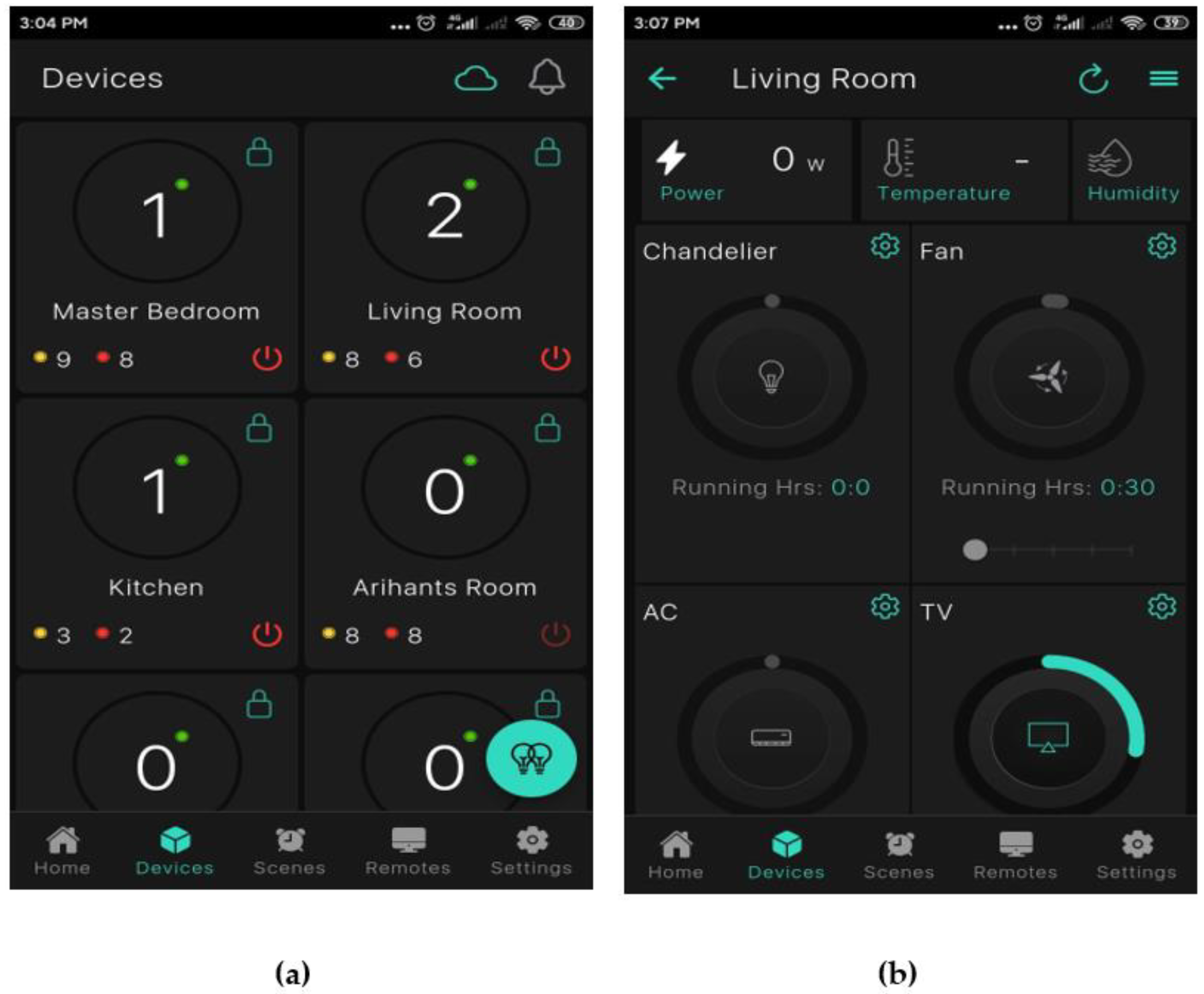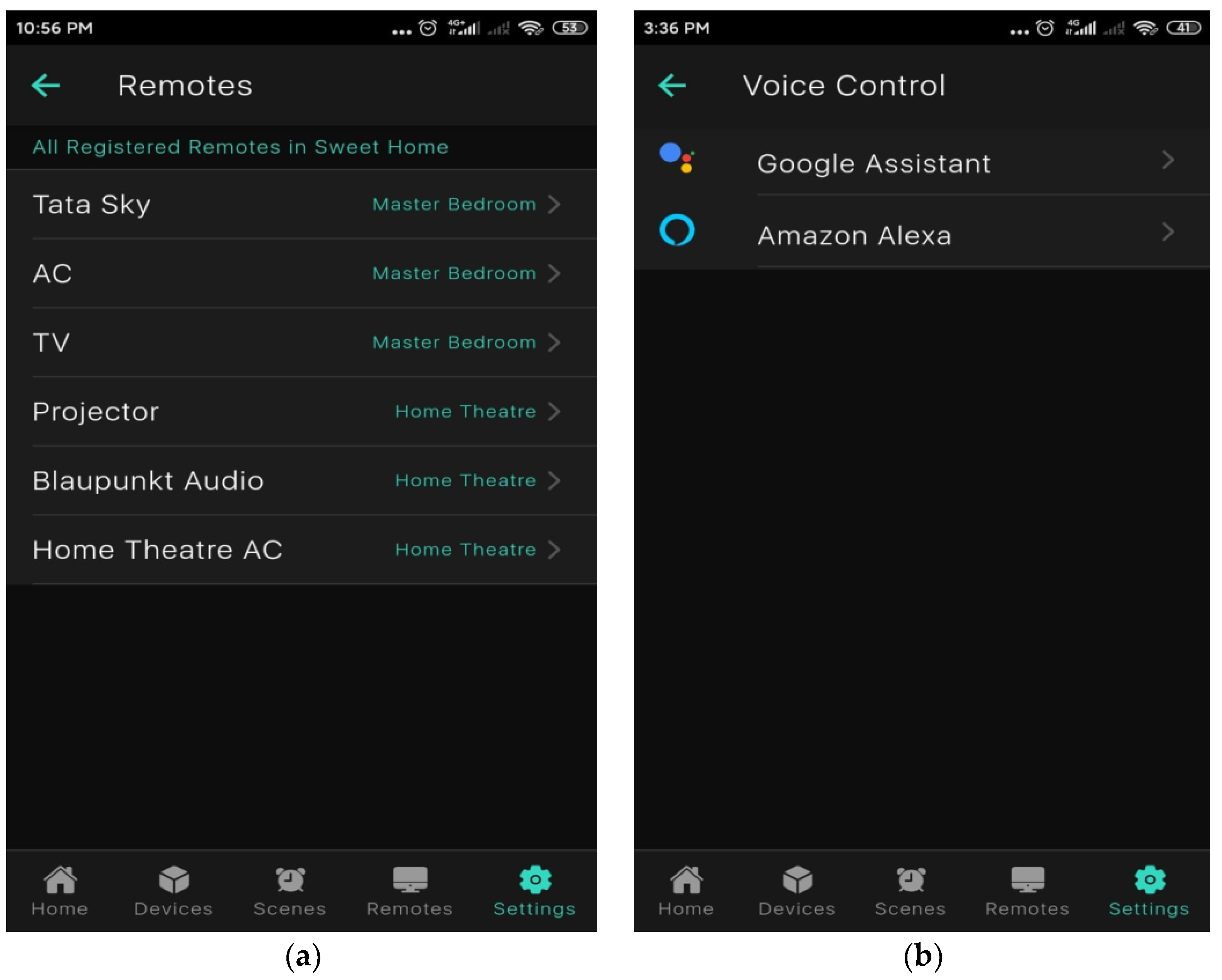Smart Android Based Home Automation System Using Internet of Things (IoT)
Abstract
:1. Introduction
- (1)
- A single and unified solution that combines all the integrated features;
- (2)
- Device management and provisioning.
- (3)
- The special firmware updated all devices using the same unique API.
- (4)
- Complex and intelligent rules are implemented between the actuators and sensors inside the network.
- (5)
- A master-slave architecture that is hierarchical and provides scalability and flexibility.
- (6)
- There is no need for a connection to the cloud (privacy and security reasons so, the user data are not confines of the local network).
- (7)
- The integrated smart phone app including plugin performs best on all top platforms, whether desktop or mobile, including Android, Windows, iOS, macOS, Linux, etc.
2. System Architecture and Design
3. Software Implementation
3.1. Programming Languages (Java, Python)
3.2. Configuring the Web App
4. Real Home Automation Case Study
4.1. Controlling Home appliances (A/C, Television, Speakers, Ceiling Lights)
4.2. Energy and Power Monitoring
4.3. Controlling Home Appliances by Using Google Assistant (Voice)
5. Discussion
6. Conclusions
Author Contributions
Funding
Institutional Review Board Statement
Informed Consent Statement
Data Availability Statement
Acknowledgments
Conflicts of Interest
Abbreviation
| IOT | Internet of Things |
| API | Application Programme Interface |
| HTTP | Hypertext Transfer Protocol |
| REST | Representational state transfer |
| JSON | JavaScript Object Notation |
| HAS | Home Automation System |
| PIC | Microchip Technology in Chandler |
| MQTT | Message Queuing Telemetry Transport |
References
- Debnath, B.; Dey, R.; Roy, S. Smart switching system using bluetooth technology. In Proceedings of the 2019 Amity International Conference on Artificial Intelligence (AICAI), Dubai, United Arab Emirates, 4–6 February 2019. [Google Scholar]
- Spadacini, M.; Savazzi, S.; Nicoli, M. Wireless home automation networks for indoor surveillance: Technologies and experiments. EURASIP J. Wirel. Commun. Netw. 2014, 2014, 6. [Google Scholar] [CrossRef]
- Javeed, D.; Gao, T.; Khan, M.T. SDN-Enabled Hybrid DL-Driven Framework for the Detection of Emerging Cyber Threats in IoT. Electronics 2021, 10, 918. [Google Scholar] [CrossRef]
- Javeed, D.; Khan, M.T.; Ahmad, I.; Iqbal, T.; Badamasi, U.M.; Ndubuisi, C.O.; Umar, A. An efficient approach of threat hunting using memory forensics. Int. J. Comput. Netw. Commun. Secur. 2020, 8, 37–45. [Google Scholar] [CrossRef]
- Al Razib, M.; Javeed, D.; Khan, M.T.; Alkanhel, R.; Muthanna, M.S.A. Cyber Threats Detection in Smart Environments Using SDN-Enabled DNN-LSTM Hybrid Framework. IEEE Access 2022, 10, 53015–53026. [Google Scholar] [CrossRef]
- Ahmad, I.; Ullah, I.; Khan, W.U.; Ur Rehman, A.; Adrees, M.S.; Saleem, M.Q.; Cheikhrouhou, O.; Hamam, H.; Shafiq, M.; Shafiq, M. Efficient algorithms for E-healthcare to solve multiobject fuse detection problem. J. Healthc. Eng. 2021, 2021, 9500304. [Google Scholar] [CrossRef]
- Ahmad, I.; Wang, X.; Zhu, M.; Wang, C.; Pi, Y.; Khan, J.A.; Khan, S.; Samuel, O.W.; Chen, S.; Li, G. EEG-Based Epileptic Seizure Detection via Machine/Deep Learning Approaches: A Systematic Review. Comput. Intell. Neurosci. 2022, 2022, 6486570. [Google Scholar] [CrossRef]
- Kumar, A.; Singh, A.K.; Ahmad, I.; Kumar Singh, P.; Anushree; Verma, P.K.; Alissa, K.A.; Bajaj, M.; Ur Rehman, A.; Tag-Eldin, E. A Novel Decentralized Blockchain Architecture for the Preservation of Privacy and Data Security against Cyberattacks in Healthcare. Sensors 2022, 22, 5921. [Google Scholar] [CrossRef]
- Ahmad, I.; Liu, Y.; Javeed, D.; Shamshad, N.; Sarwr, D.; Ahmad, S. A review of artificial intelligence techniques for selection & evaluation. IOP Conf. Ser. Mater. Sci. Eng. 2020, 853, 012055. [Google Scholar]
- Murthy, A.; Irshad, M.; Noman, S.M.; Tang, X.; Hu, B.; Chen, S.; Khader, G. Internet of Things, a vision of digital twins and case studies. In IoT and Spacecraft Informatics; Elsevier: Amsterdam, The Netherlands, 2022; pp. 101–127. [Google Scholar]
- Anandhavalli, D.; Mubina, N.S.; Bharath, P. Smart Home Automation Control Using Bluetooth and GSM. Int. J. Inf. Futur. Res. 2015, 2, 2547–2552. [Google Scholar]
- Baraka, K.; Ghobril, M.; Malek, S.; Kanj, R.; Kayssi, A. Low Cost Arduino/Android-Based Energy-Efficient Home Automation System with Smart Task Scheduling. In Proceedings of the 2013 5th International Conference on Computational Intelligence, Communication Systems and Networks, Madrid, Spain, 5–7 June 2013; pp. 296–301. [Google Scholar]
- Zamora-Izquierdo, M.A.; Santa, J.; Gomez-Skarmeta, A.F. An Integral and Networked Home Automation Solution for Indoor Ambient Intelligence. IEEE Pervasive Comput. 2010, 9, 66–77. [Google Scholar] [CrossRef]
- Bhide, V.H.; Wagh, S. i-learning IoT: An intelligent self learning system for home automation using IoT. In Proceedings of the 2015 International Conference on Communications and Signal Processing (ICCSP), Melmaruvathur, India, 2–4 April 2015. [Google Scholar]
- Froiz-Míguez, I.; Fernández-Caramés, T.M.; Fraga-Lamas, P.; Castedo, L. Design, Implementation and Practical Evaluation of an IoT Home Automation System for Fog Computing Applications Based on MQTT and ZigBee-WiFi Sensor Nodes. Sensors 2018, 18, 2660. [Google Scholar] [CrossRef] [PubMed]
- Li, Z.M.; Song, M.; Gao, L. Design of Smart Home System Based on Zigbee. Appl. Mech. Mater. 2014, 635–637, 1086–1089. [Google Scholar] [CrossRef]
- Vivek, G.; Sunil, M. Enabling IOT services using WIFI-ZigBee gateway for a home automation system. In Proceedings of the 2015 IEEE International Conference on Research in Computational Intelligence and Communication Networks (ICRCICN), Kolkata, India, 20–22 November 2015; pp. 77–80. [Google Scholar]
- Huang, F.-L.; Tseng, S.-Y. Predictable smart home system integrated with heterogeneous network and cloud computing. In Proceedings of the 2016 International Conference on Machine Learning and Cybernetics (ICMLC), Jeju, Korea, 10–13 July 2016; Volume 2, pp. 649–653. [Google Scholar]
- Kodali, R.K.; Jain, V.; Bose, S.; Boppana, L. IoT-based smart security and home automation system. In Proceedings of the 2016 International Conference on Computing, Communication and Automation (ICCCA), Noida, India, 29–30 April 2016; pp. 1286–1289. [Google Scholar]
- Ullah, K.T. Internet of Things (IOT) systems and its security challenges. Int. J. Adv. Res. Comput. Eng. Technol. (IJARCET) 2019, 8, 1–12. [Google Scholar]
- Javeed, D.; Gao, T.; Khan, M.T.; Ahmad, I. A hybrid deep learning-driven SDN enabled mechanism for secure communication in Internet of Things (IoT). Sensors 2021, 21, 4884. [Google Scholar] [CrossRef]
- Li, L.; Jiang, L.; Liu, Z. Optimization Research of Artificial Intelligence and Wireless Sensor Networks in Smart Pension. Sci. Program. 2021, 2021, 5421668. [Google Scholar] [CrossRef]
- Nisar, K.; Ibrahim AA, A.; Wu, L.; Adamov, A.; Deen, M.J. Smart home for elderly living using Wireless Sensor Networks and an Android application. In Proceedings of the 2016 IEEE 10th International Conference on Application of Information and Communication Technologies (AICT), Baku, Azerbaijan, 12–14 October 2016. [Google Scholar]
- Yan, W.; Wang, Q.; Gao, Z.; Zhenwei, G. Smart home implementation based on Internet and WiFi technology. In Proceedings of the 34th Chinese Control Conference (CCC), Hangzhou, China, 28–30 July 2015; pp. 9072–9077. [Google Scholar]
- Shafana, A.R.F.; Aridharshan, A. Android based automation and security system for smart homes. Int. J. Comput. Sci. Inf. Technol. Res. 2017, 5, 26–30. [Google Scholar]
- Stolojescu-Crisan, C.; Crisan, C.; Butunoi, B.P. An IoT-based smart home automation system. Sensors 2021, 21, 3784. [Google Scholar] [CrossRef]
- Ji, X.-P.; Liu, W.; Liu, G.; Zhai, J.; Tian, W.; Lin, R. Defense Strategies Against Network Attacks in Cyber-Physical Systems with Analysis Cost Constraint Based on Honeypot Game Model Artificial Intelligence for Multimedia Content Analysis View project Distributed Parameter System View project Defense Strategies Against Network Attacks in Cyber-Physical Systems with Analysis Cost Constraint Based on Honeypot Game Model. CMC Comput. Mater. Contin. 2019, 60, 193–211. [Google Scholar] [CrossRef]
- Mobile Operating System Market Share Worldwide|Statcounter Global Stats. Available online: https://gs.statcounter.com/os-market-share/mobile/worldwide/2019 (accessed on 11 April 2022).
- Tomlinson, J.J. Strategic planning for bioanalytical automation: Managing growth successfully. J. Autom. Chem. 1992, 14, 47–50. [Google Scholar] [CrossRef]
- Kaleshi, D. Ensuring interoperability in a home networking system: A case study. IEEE Trans. Consum. Electron. 1999, 45, 1134–1143. [Google Scholar] [CrossRef]
- Majeed, R.; Abdullah, N.A.; Ashraf, I.; Zikria, Y.B.; Mushtaq, M.F.; Umer, M. An Intelligent, Secure, and Smart Home Automation System. Sci. Program. 2020, 2020, 4579291. [Google Scholar] [CrossRef]
- Openhab 3.0 Release openHAB. Available online: https://www.openhab.org/blog/2020-12-21-openhab-3-0-release.html (accessed on 11 April 2022).
- Triantafyllou, A.; Sarigiannidis, P.; Lagkas, T.D. Network protocols, schemes, and mechanisms for Internet of Things(IoT): Features, open challenges, and trends. Wirel. Commun. Mob. Comput. 2018, 2018, 5349894. [Google Scholar] [CrossRef]
- Khan, M.T.; Akhunzada, A.; Zeadally, S. Proactive Defense for Fog-to-Things Critical Infrastructure. IEEE Commun. Mag. 2022. [Google Scholar] [CrossRef]
- Stolojescu-Crisan, C.; Butunoi, B.-P.; Crisan, C. IoT based intelligent building applications in the context of covid-19 pandemic. In Proceedings of the 2020 International Symposium on Electronics and Telecommunications (ISETC), Timisoara, Romania, 5–6 November 2020. [Google Scholar] [CrossRef]
- Jabbar, W.A.; Alsibai, M.H.; Amran, N.S.S.; Mahayadin, S.K. Design and Implementation of IoT-Based Automation System for Smart Home. In Proceedings of the International Symposium on Networks, Computers and Communications (ISNCC), Rome, Italy, 19–21 June 2018; pp. 1–6. [Google Scholar]
- Gupta, P.; Chhabra, J. IoT based Smart Home design using power and security management. In Proceedings of the 2016 International Conference on Innovation and Challenges in Cyber Security (ICICCS-INBUSH), Noida, India, 3–5 February 2016; pp. 6–10. [Google Scholar]
- Krichen, M.; Mechti, S.; Alroobaea, R.; Said, E.; Singh, P.; Khalaf, O.I.; Masud, M. A formal testing model for operating room control system using internet of things. Comput. Mater. Contin. 2021, 66, 2997–3011. [Google Scholar] [CrossRef]
- Pandya, B.; Mehta, M.; Jain, N.; Kadam, S. Android Based Home Automation System Using Bluetooth & Voice Command–Implementation. Int. Res. J. Eng. Technol. 2016, 3, 2395–0056. Available online: https://www.academia.edu/download/54561529/IRJET-V3I4265.pdf (accessed on 11 April 2022).
- Openmotics, Open Source Home Automation. Available online: www.openmotics.com/en/ (accessed on 8 August 2022).
- Nedelcu, A.-V.; Sandu, F.; Machedon-Pisu, M.; Alexandru, M.; Ogrutan, P. Wireless-based remote monitoring and control of intelligent buildings. In Proceedings of the 2009 IEEE International Workshop on Robotic and Sensors Environments, Lecco, Italy, 6–7 November 2009; pp. 47–52. [Google Scholar]
- Fernández-Caramés, T.M. An Intelligent Power Outlet System for the Smart Home of the Internet of Things. Int. J. Distrib. Sens. Netw. 2015, 11, 214805. [Google Scholar] [CrossRef]
- OpenHAB. Available online: http://www.openhab.org/ (accessed on 1 February 2022).
- Home-Assistant Official Web Page. Available online: http://wwww.home-assistant.io/ (accessed on 1 February 2022).
- Domoticz Official Web Page. Available online: http://domoticz.com/ (accessed on 1 February 2022).
- Calaos Official Web Page. Available online: https://calaos.fr/en// (accessed on 1 February 2022).
- Jeedom Official Web Page. Available online: https://www.jeedom.com/ (accessed on 1 February 2022).
- Fehm Official Web Page. Available online: http://www.fhem.de/fhem.html// (accessed on 1 February 2022).
- Ali, S.; Javaid, N.; Javeed, D.; Ahmad, I.; Ali, A.; Badamasi, U.M. A blockchain-based secure data storage and trading model for wireless sensor networks. In Proceedings of the International Conference on Advanced Information Networking and Applications, Caserta, Italy, 15–17 April 2020; Springer: Cham, Switzerland, 2020. [Google Scholar]
- Shahajan, M.; Islam, G.J.; Das, S.K.; Islam, S.; Islam, M.; Islam, K.K. Internet of Things (IoT) based automatic electrical energy meter billing system. J. Electron. Commun. Eng. 2019, 14, 39–50. [Google Scholar]
- Islam, U.; Muhammad, A.; Mansoor, R.; Hossain, M.S.; Ahmad, I.; Eldin, E.T.; Khan, J.A.; Rehman, A.U.; Shafiq, M. Detection of Distributed Denial of Service (DDoS) Attacks in IOT Based Monitoring System of Banking Sector Using Machine Learning Models. Sustainability 2022, 14, 8374. [Google Scholar] [CrossRef]
- Singh, S.; Sharma, P.K.; Park, J.H. SH-SecNet: An enhanced secure network architecture for the diagnosis of security threats in a smart home. Sustainability 2017, 9, 513. [Google Scholar] [CrossRef]
- Longe, O.M.; Ouahada, K.; Rimer, S.; Harutyunyan, A.N.; Ferreira, H.C. Distributed demand side management with battery storage for smart home energy scheduling. Sustainability 2017, 9, 120. [Google Scholar] [CrossRef]
- Sintov, N.D.; Schultz, P.W. Adjustable green defaults can help make smart homes more sustainable. Sustainability 2017, 9, 622. [Google Scholar] [CrossRef]
- Byun, J.; Park, S.; Cho, K.; Park, S. Zone-aware service platform: A new concept of context-aware networking and communications for smart-home sustainability. Sustainability 2018, 10, 266. [Google Scholar] [CrossRef]
- Azad KM, S.; Hossain, N.; Samia, N.A.; Islam, M.J.; Hossain, A.; Kabir, S. A Cost-Effective Internet of Things Based Smart Home System for Upcoming Technologies. In Proceedings of the 2021 International Conference on Automation, Control and Mechatronics for Industry 4.0 (ACMI), Rajshahi, Bangladesh, 8–9 July 2021. [Google Scholar]
- Choi, W.; Kim, J.; Lee, S.; Park, E. Smart home and internet of things: A bibliometric study. J. Clean. Prod. 2021, 301, 126908. [Google Scholar] [CrossRef]
- Ahmad, S.; Ullah, T.; Ahmad, I.; Al-Sharabi, A.; Ullah, K.; Khan, R.A.; Rasheed, S.; Ullah, I.; Uddin, N.; Ali, S. A Novel Hybrid Deep Learning Model for Metastatic Cancer Detection. Comput. Intell. Neurosci. 2022, 2022, 8141530. [Google Scholar] [CrossRef] [PubMed]
- Ahmad, I.; Liu, Y.; Javeed, D.; Ahmad, S. A decision-making technique for solving order allocation problem using a genetic algorithm. IOP Conf. Ser. Mater. Sci. Eng. 2020, 853, 012054. [Google Scholar] [CrossRef]
- Ullah, N.; Khan, J.A.; Alharbi, L.A.; Raza, A.; Khan, W.; Ahmad, I. An Efficient Approach for Crops Pests Recognition and Classification Based on Novel DeepPestNet Deep Learning Model. IEEE Access 2022, 10, 73019–73032. [Google Scholar] [CrossRef]
- Tufail, A.B.; Ullah, I.; Khan, W.U.; Asif, M.; Ahmad, I.; Ma, Y.-K.; Khan, R.; Kalimullah; Ali, M. Diagnosis of diabetic retinopathy through retinal fundus images and 3D convolutional neural networks with limited number of samples. Wirel. Commun. Mob. Comput. 2021, 2021, 6013448. [Google Scholar] [CrossRef]
- Wang, Y.; Taylan, O.; Alkabaa, A.S.; Ahmad, I.; Tag-Eldin, E.; Nazemi, E.; Balubaid, M.; Alqabbaa, H.S. An Optimization on the Neuronal Networks Based on the ADEX Biological Model in Terms of LUT-State Behaviors: Digital Design and Realization on FPGA Platforms. Biology 2022, 11, 1125. [Google Scholar] [CrossRef]
- Rehman, A.U.; Naqvi, R.A.; Rehman, A.; Paul, A.; Sadiq, M.T.; Hussain, D. A Trustworthy SIoT Aware Mechanism as an Enabler for Citizen Services in Smart Cities. Electronics 2020, 9, 918. [Google Scholar] [CrossRef]








| References | Controller | User Interface | Communication | Application |
|---|---|---|---|---|
| [16] | PIC (Microchip Technology in Chandler) | mobile application | Bluetooth | Manage the operation of indoor appliances |
| [7] | Arduino | mobile application | Bluetooth | Both indoor and outdoor control appliances at a short distance |
| [18] | Arduino mega | mobile application | Ethernet, ZigBee | Control indoor appliances |
| [19] | Raspberry PI | ZigBee, Wi-Fi | Regulating humidity, temperature, brightness, movement, and electrical currents | |
| [20] | PC server/Laptop | mobile application | ZigBee | Management of interior appliances; however, it is not put into action |
| [21] | TI-CC3200 | mobile application | Wi-Fi | Manage the operation of indoor appliances, and monitor the moisture of the soil |
| Proposed System | Raspberry PI, Arduino mega | Web-based and mobile applications | Wi-Fi | Multiple home automation (indoor and outdoor), security management, energy prediction, Statics power and management, and Google Assistant compatibility. |
| System | API | Programming Language | Other Possible Feature |
|---|---|---|---|
| [43] Open Hub | Representational state transfer (REST) | JAVA | Extensive documentation, many protocols, web interface, MQTT (Message Queuing Telemetry Transport |
| [44] Domoticz | Based on JSON (JavaScript Object Notation) | C++ | Few protocols, MQTT (Message Queuing Telemetry Transport), web interface, extensive documentation |
| [47] Jeedom | HTTP and JSON (JavaScript Object Notation) based | PHP | Extensive documentation, many plugins, a web interface, and many protocols. |
| [44] Home Assistant | Python/REST | Python | Extensive documentation, many protocols, web interface, MQTT (Message Queuing Telemetry Transport). |
| Proposed system | Rest and JSON based | Python | HTTP, web interface, expanded documentation (French, English, Chinese), few plugins, many protocols, Apache 2.0. |
| Actuator/Sensor | Measurement Range | Name | Consumption | Expense |
|---|---|---|---|---|
| Power meter | 90–250 V | Mai-90 | 2 W | $20–30 |
| Temperature | 5–50 °C | ME81H | 400 mA | $15–25 |
| Touch sensor | logic | Sonoff Touch | 0.6 W | $20–25 |
| 4-relay module | - | SunSmart | 5–70 mA | $4–6 |
Publisher’s Note: MDPI stays neutral with regard to jurisdictional claims in published maps and institutional affiliations. |
© 2022 by the authors. Licensee MDPI, Basel, Switzerland. This article is an open access article distributed under the terms and conditions of the Creative Commons Attribution (CC BY) license (https://creativecommons.org/licenses/by/4.0/).
Share and Cite
Khan, M.A.; Ahmad, I.; Nordin, A.N.; Ahmed, A.E.-S.; Mewada, H.; Daradkeh, Y.I.; Rasheed, S.; Eldin, E.T.; Shafiq, M. Smart Android Based Home Automation System Using Internet of Things (IoT). Sustainability 2022, 14, 10717. https://doi.org/10.3390/su141710717
Khan MA, Ahmad I, Nordin AN, Ahmed AE-S, Mewada H, Daradkeh YI, Rasheed S, Eldin ET, Shafiq M. Smart Android Based Home Automation System Using Internet of Things (IoT). Sustainability. 2022; 14(17):10717. https://doi.org/10.3390/su141710717
Chicago/Turabian StyleKhan, Muhammad Abbas, Ijaz Ahmad, Anis Nurashikin Nordin, A. El-Sayed Ahmed, Hiren Mewada, Yousef Ibrahim Daradkeh, Saim Rasheed, Elsayed Tag Eldin, and Muhammad Shafiq. 2022. "Smart Android Based Home Automation System Using Internet of Things (IoT)" Sustainability 14, no. 17: 10717. https://doi.org/10.3390/su141710717
APA StyleKhan, M. A., Ahmad, I., Nordin, A. N., Ahmed, A. E.-S., Mewada, H., Daradkeh, Y. I., Rasheed, S., Eldin, E. T., & Shafiq, M. (2022). Smart Android Based Home Automation System Using Internet of Things (IoT). Sustainability, 14(17), 10717. https://doi.org/10.3390/su141710717









